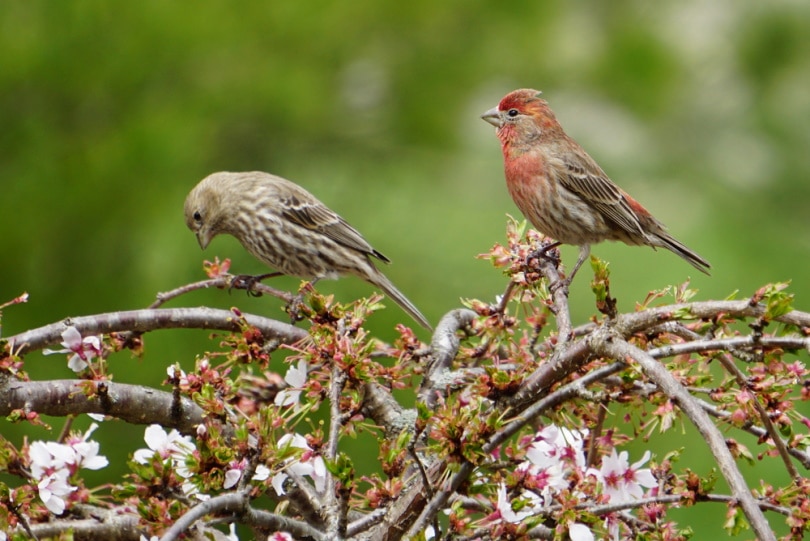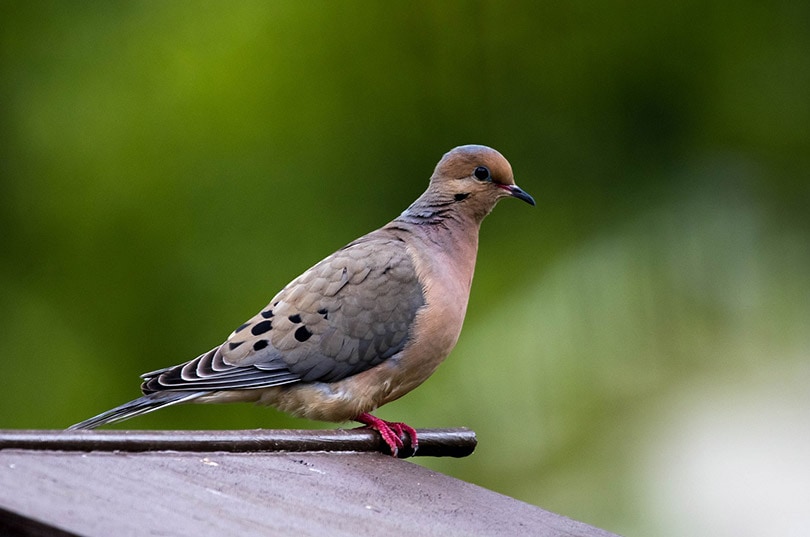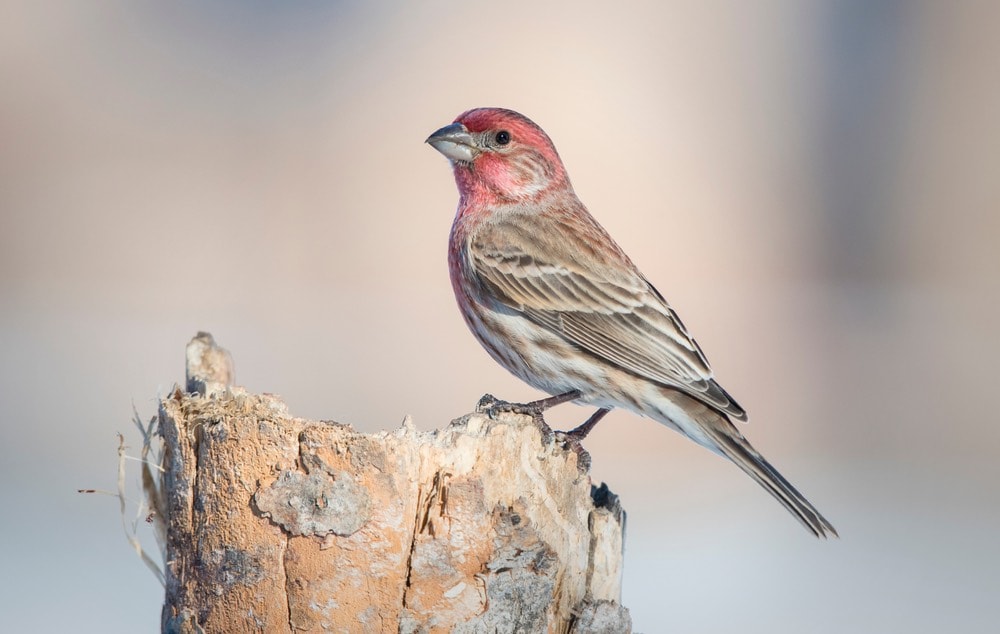10 Common Backyard Birds in Arizona (with Pictures)
Last Updated on

The wilds of Arizona are home to many wonderful creatures and sights. Arizona’s avian species are as varied as the rest of its wildlife. Featuring birds native to Arizona and a large host of migratory species, Arizona’s bird variety is quite extensive. Whether these delightful creatures are out in the wild or singing their songs in your backyard, Arizona’s avian wildlife is always there to be seen as long as you know where to look.
Let’s take a look at some of the most recognizable and well-known birds in Arizona, especially the ones found close to home visiting your backyard. Some of these species live in Arizona year-round, while others are migratory and only part-time residents and visitors.
We’ve included the most common backyard visitors in this list, but that doesn’t mean these are the only birds you might see.

The 10 Most Common Backyard Birds in Arizona
Arizona’s birds can be observed at backyard feeders, parks, forests, or in your parking lot. Whether you’re seeking brown birds, songbirds, or more colorful red birds, the list below is likely to include them.
1. Mourning Dove

| Length | 9.1–13.4 inches |
| Weight | 3–6 ounces |
| Wingspan | 17.7 inches |
About the size of pigeons, doves are incredibly common in backyards. Mourning doves are mostly gray with black spots on top, a pale peach color below, and pink legs. You can often find them just about anywhere in the state of Arizona. They will sit perched on telephone wires, fence posts, or even in groups in trees or bushes around your home. Mourning doves are year-round residents in Arizona, and they prefer semi-open areas such as urban areas, farmlands, and woods.
Mourning doves primarily eat grains and seeds and consume berries or other fruit when available. The doves will migrate during the winter months to avoid harsh weather conditions and food shortages.
They visit seed feeders more often than other birds, but they still prefer seeds that have already fallen to the ground. If you want to attract doves to your backyard, set up a ground feeder or simply scatter seeds around your yard.
2. House Finch

| Length | 5.1–5.5 inches |
| Weight | 0.6–0.9 ounces |
| Wingspan | 7.9-9.8 inches |
House finches are common in North America, and you will find them in backyards regardless of the state you live in. These year-long residents do not migrate and have become so populous they have even pushed out the purple finch. While there are other types of red finches in the state and finch family, the house finch is the most common in our residential areas.
Male house finches have red heads and breasts, and the rest of their bodies are mainly brown-streaked, but the females are brown-streaked all over—making it easy to distinguish between the two. You can find small flocks of house finches on wires, in short treetops, and in bushes. They can also be found in parks, farms, forest edges, and backyard feeders in noisy groups that are hard to miss.
House finches primarily feed on seeds, grains, or fruits. During the winter, the finches migrate to warmer climates, where their diet shifts more towards insects and weeds. If you want to attract the birds to your property, try to include a thistle or seed feeder in your space.
3. White-Winged Dove

| Length | 12 inches |
| Weight | 4.4–6.6 ounces |
| Wingspan | 18.9–22.8 inches |
White-winged doves can be seen during the spring and summer breeding seasons, frequenting areas throughout Southern Arizona due to its warmer climate. White-winged doves, like most other dove species, prefer to scour the ground for food.
However, unlike mourning doves, white-winged doves are pale gray-brown with a black line on their cheeks and a white stripe along the edges of their closed wing.s This color pattern creates a striking image of a large, white line during flight.
You can attract white-winged doves to your yard with sunflower or corn on platform feeders. If you happen to have saguaro cactus around you, the doves are likely to visit your property. Also, planting native berry-producing shrubs can draw them in.
4. Gila Woodpecker

| Length | 8.7–9.4 inches |
| Weight | 1.8–2.8 ounces |
| Wingspan | 15.8–16.5 inches |
While having a name reminiscent of a Gila monster, the Gila woodpecker is actually a year-round resident. These cactus-loving woodpeckers regularly spend their time in Arizona’s forested areas, pine forests, and deserts. If there are Saguaro Cacti about, you can guarantee that a Gila woodpecker is not far behind. This is because the Gila Woodpecker hollows out the top of the cactus to construct its home. These little wonders can often be seen and heard on a cool morning in the desert on top of the cactus.
Gila woodpeckers are known to be very colorful. While they have tan heads and bellies, they also have bold black and white stripes along their wings and tails. Male Gila woodpeckers have red patches on their foreheads while the females do not.
Despite mainly living in the desert, this species will venture into other habitats as long as there are Saguaros around. A Gila woodpecker’s diet consists of spiders, scorpions, and centipedes. These birds have even been known to eat other small birds in certain situations.
If you live near one of their various habitats, you may find the woodpeckers in your backyard as long as you offer corn, suet, or nuts.
5. Lesser Goldfinch

| Length | 3.5–4.3 inches |
| Weight | 0.3–0.4 ounces |
| Wingspan | 5.9–7.9 inches |
Lesser goldfinches will usually spend the breeding season in northern Arizona, but they also live in the southern parts of Arizona all year. These yellow and black songbirds can be found in large flocks that frequent open habitats like thickets, weedy fields, forest clearings, parks, and even gardens. Lesser goldfinches will visit prairies, meadows, and orchards where they can find grasses with seeds that produce plants for their diet.
Lesser goldfinches are far from solitary creatures. More likely than not, you will see a Lesser goldfinch intermixed in a flock with other members of the finch family or even sparrows. You can always tell the lesser goldfinch apart due to its unique coloring and overall appearance. They are incredibly small, bright yellow songbirds with contrasting black feathers. Female lesser goldfinches have olive backs and duller yellowbellies compared to the males.
Lesser Goldfinches are foragers. You can find them hunting around for seeds, but their favorite food is sunflower seeds. They also eat buds from cottonwood, willow, sycamore, and alder trees.
In order to bring these yellow beauties to your backyard, try adding sunflower seeds or thistle seeds to your platform feeders.
6. Verdin

| Length | 3.5–4.3 inches |
| Weight | 0.2–0.3 ounces |
| Wingspan | 7 Inches |
Verdins are another year-round resident of Arizona. They are easily identifiable by their color pattern. Verdins are tiny desert birds with small yellow heads, light gray bodies, and reddish-brown patches on top of their wings.
Verdins are more active in the mornings to escape the infamous Arizona heat. Because they frequent the hot, dry regions, verdins will exert their energy before the sun reaches its peak. Verdins will often quiet down as the midday sun rises, so your best bet of finding them is in the early morning.
You will primarily find Verdins in desert shrubs or bushes within Arizona’s plentiful arroyos. Verdins build habitats in a variety of trees like acacias, junipers, and willows. Verdins are very agile little birds, especially when navigating the trees and hunting for their main meals. Their diet is made up of whatever they can catch—usually insects like caterpillars, wasps, bees, or spiders. They will also go for fruit and drink the nectar from flowers they find while hunting.
You can attract these agile hunters to your backyard with hummingbird feeders or native trees and shrubs.
7. Anna’s Hummingbird

| Length | 3.9 inches |
| Weight | 0.1–0.2 ounces |
| Wingspan | 4.7 inches |
While more common during the spring and fall migration periods, Anna’s hummingbirds can be spotted year-round in Arizona as long as you know where to look, and you plant the right bait in your yards. These delightful birds are the most plentiful during the spring when you can find them hovering around colorful blossoms and hummingbird feeders filled with hummingbird nectar.
Though all hummingbird species are known for their diminutive stature, Anna’s hummingbirds happen to be one of the smallest species in the hummingbird family.
These little beauties can be easily identified by their iridescent colors and very long tail. Anna’s hummingbirds are capable of a specific fluttering motion that makes their distinctive, low buzzing noise. They are capable of creating two different songs, and both are easily recognizable.. You can tell male Anna’s hummingbirds apart because their heads and throats are shimmering reddish-pink while the females’ throats are iridescent gray with red spots.
Anna’s Hummingbirds tend to eat nectar, insects, and fruits that it finds during their travels. You can attract them to your backyard with nectar feeders and colorful plants.
8. Curve-billed Thrasher

| Length | 10.6–11.0 inches |
| Weight | 2.1–3.3 ounces |
| Wingspan | 13.4–13.6 inches |
The curve-billed thrashers are not native to Arizona, but they migrate seasonally to warmer climates like Arizona, Texas, and Southern California. You can find this avian across much of western North America, but if you’re looking for them in Arizona you will have the best luck during the vicious heat of the summer months. Curve-billed thrashers make deserts, savannas, scrublands, and grasslands their home. You will find them primarily near water sources where they are able to feed on beetles, crickets, or grasshoppers.
A curve-billed thrasher is a short, stout bird with a dull grayish-brown throat and intermittently spotted underbelly. Its downward-curved beak is solid black and sturdy enough to be used as a broom and vacuum as tit sweep its head back and forth through leaves while hunting for insects. Thrashers also eat fruit, seeds, and sometimes even flowers, but their primary nutrition comes from the bugs they catch inside fallen leaves. If you’re unsure of whether or not your newly found leaf-sweeper is indeed a curve-billed thrasher, its call is often described as similar to the high-pitched whistling noise someone might make when hailing a cab.
Curve-billed thrashers are more likely to pick up seeds on the ground or from large platform feeders you set up in your backyard. Offer cracked corn, sunflower, and millet. You can also attract them by providing fresh water!
9. Yellow-rumped Warblers

| Length | 4.7–5.5 inches |
| Weight | 0.4–0.5 ounces |
| Wingspan | 7.5–9.1 inches |
Yellow-rumped warblers are usually found near water during Arizona’s winter months. You will find them primarily in wide-open spaces with plenty of vegetation, like forests or meadows. During their migration periods, Yellow-rumped warblers will flock to areas with lakes, rivers, or fields with ponds where they can feast on mosquitos and flies.
During the summer months, yellow-rumped warblers rely on the insects they find during their migration pattern. Whereas, during the winter, these frisky birds shift to a fruit diet. This shift helps the yellow-rumped warbler through their migration periods.
You can tell these resourceful birdies apart from a flock due to their gray coloring with splashes of yellow on their faces, wings, and backside. They also have distinctive white spots inside of their wings.
If you want to bring yellow-rumped warblers to your backyard, provide sunflower seeds, raisins, and peanut butter!
10. White-Crowned Sparrow

| Length | 5.9–6.3 inches |
| Weight | 0.9–1.0 ounces |
| Wingspan | 8.3–9.4 inches |
White-crowned sparrows prefer the cold to the heat, and they tend to only migrate back through the United States during the colder winter months. These members of the sparrow family can be found from southern Alaska, through Washington and Oregon, into northern California. White-crowned sparrows can be found throughout Arizona only during the fall and winter. You will primarily find white-crowned sparrows inside grasslands or bushy areas, but they occasionally visit residential areas during their migration flights. They like to forage in fields and the edges of roads and trails. So keep an eye out on your next winter hike!
White-Crowned Sparrows appear almost regal due to their bold striping across their heads While the rest of their face, bodies, and wings stay the same brownish gray color, the distinctive striping along their heads helps white-crowned sparrows stand apart from the crowd.
White-crowned sparrows readily visit backyard feeders and like to pick up fallen seeds. You can provide sunflower, millet, and mixed seed blends to bring them to your home!

How To Attract Birds to Your Yard
While these tips may help, they won’t guarantee that birds will visit your yard.
- Bird feeders are essential when trying to draw birds into your backyard. We’ve mentioned different types of feeders throughout this article, and for a good reason. Providing a bird feeder in your yard is a sure-fire way to get our flight-filled friends to visit. Make sure to offer them options like a tube feeder or platform feeder, so the different species of birds have choices!
- Water sources are equally as important as your feeders. Try to ensure your backyard includes a birdbath, a fountain, or even a stream. Birds need water to drink and bathe in, and adding one of these will almost double your chances of bringing birds into your backyard.
- Plants for food and shelter are equally as appealing to our flying friends. If you plant native flowers, trees, or shrubs, you are not only providing shelter similar to the birds’ natural habitat, but you will also be mimicking the food sources they seek out in the wild. Native Arizona plants are the perfect segway to turning your home into a regular bird paradise.
- Grow grass to provide shelter. Especially if you want to attract sparrows and other ground-hopping birds to your yard, your grass needs to be long enough to give them enough of a sense of security to where they feel safe to touch the ground. All the bird feeders and water fountains won’t make a difference if the birds visiting your yard feel unsafe. Make sure that your yard has a variety of trees, bushes, and grass where the birds can hide if they feel like they are in danger.
- Be mindful of chemicals. If you are a gardener or someone with a green thumb, you may be scaring birds away from your yard if you use chemicals when gardening. Avoid using pesticides or herbicides, even weedkillers, because they can be toxic to the birds.
- Create safe spaces and habitats for your visitors. This suggestion may seem self-explanatory, but setting up birdhouses or mimicking bird nests in your yard can draw birds in as much as your feeders can. Birds crave a safe space to rest, and providing them with birdhouses is a great way to provide shelter.

Final Thoughts
Armed with the knowledge and resources to take on the avians of Arizona, you can now step confidently into your backyard (or front yard) and identify your favorite frequent flyers. Whether you want to identify the birds around your home or you are seeking to make new animal friends, you can create a wonderful yard and wave hello to the most common backyard birds Arizona has to offer.
Featured Image Credit: Chris Chaney, Shutterstock
About the Author Samantha Reed
Samantha has been a freelance writer since 2014. Samantha wrote full time while in school, and continues her passion for writing while working as a full-time educator. She currently teaches Middle School English Language Arts and always encourages writing activities in her classrooms. If she is not writing, you can often find her reading or binge watching another Netflix series and spending time with her cat, Raven.
Related Articles:
Monocular vs Telescope: Differences Explained (With Pictures)
10 Types of Hummingbirds in Arkansas (With Pictures)
8 Types of Hummingbirds in Nebraska (With Pictures)
5 Types of Hummingbirds in Idaho (With Pictures)
3 Types of Hummingbirds in Mississippi (With Pictures)
8 Types of Hummingbirds in Kansas (With Pictures)
5 Types of Hummingbirds in West Virginia (With Pictures)
5 Types of Hummingbirds in Ohio (With Pictures)
